Animal's regulation
1/28
Earn XP
Description and Tags
Animal's regulation, including human, explained in a NUTshell!
Name | Mastery | Learn | Test | Matching | Spaced |
|---|
No study sessions yet.
29 Terms
Cell Specialisation
Multicellular organisms have different cell types.
Each type performs a specific function.
Specialised cells → tissues → organs → systems.
Human Digestive System: Function
Breaks down food into molecules.
Molecules pass into bloodstream & through cell membranes.
Provides nutrients (e.g. glucose) for energy.
Lego car: the digestive system breaks down the lego house into bricks and the cells builds a lego car or something else that is different
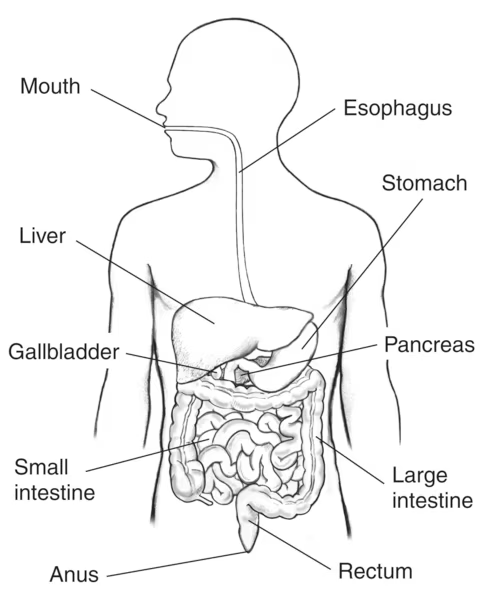
What Gets Digested?
Macromolecule | Breaks Down Into | Location | Enzyme |
|---|---|---|---|
Protein | Amino acids | Small intestine, Stomach | Proteases |
Carbohydrate | Glucose / Monosaccharides | Mouth & Small intestine | Amylase |
Lipids | Fatty acids & Glycerol / Monoglycerides | Small intestine | Lipases |
Types of Digestion / Process
Mechanical: Mouth (chewing), Stomach (churning) → smaller pieces, ↑ SA:V.
Chemical: Mouth, Stomach, Small Intestine (uses enzymes and acids) break food into simplest molecules.
Enzymes
→ Speed up chemical reactions4 Phases of Food Processing
Ingestion → 2. Digestion → 3. Absorption → 4. Elimination/Excretion/Egestion
Digestive System: Organs
Main organs (food passes through): Mouth, Esophagus, Stomach, Small Intestine, Large Intestine, Rectum, Anus
Accessory organs (no food pass): Pancreas, Liver, Gallbladder
*Esophagus Transit Time
→ 4–10 seconds via peristalsis (muscle movement)*Pathway of Food
→ Mouth → Esophagus → Stomach → Small Intestine → Large Intestine → Rectum → Anus
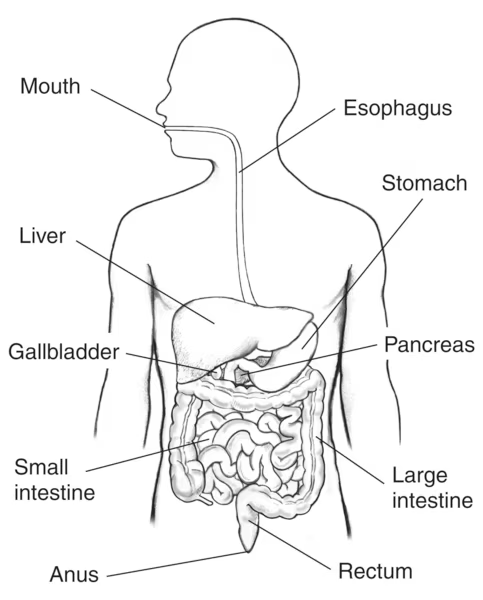
Digestion in Mouth
Teeth: Chewing → mechanical digestion
Salivary glands: Release saliva
Contains amylase → breaks starch → glucose
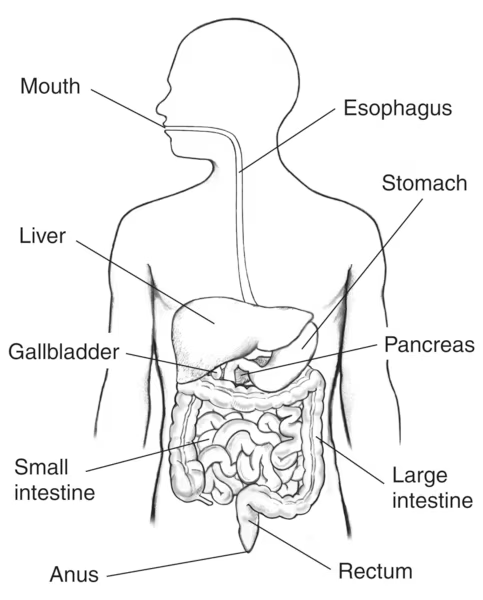
Digestion in Stomach
Muscular walls: Mechanical digestion through muscular wall movement with chemical digestion (gastric juices)
Gastric glands:
Secrete gastric juice:
Protease → digests proteins
HCl → acidic pH (1.5–3.5), activates enzymes
Mucous → protects stomach lining from acid (if without → Acid burns stomach lining → system failure)
Time in Stomach
→ ~4 hours → turns food into chyme (watery liquid)
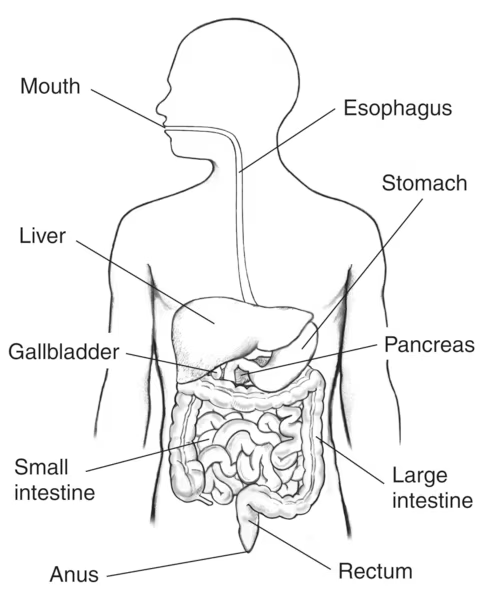
Digestion in Small Intestine
Main site for digestion + absorption
Where Chyme goes to
→ receives juices from liver & pancreasVilli/Microvilli → ↑ surface area, absorb nutrients via diffusion/osmosis/active transport
Mechanical: Bile (liver → gallbladder) breaks fats into droplets
Chemical (pancreas enzymes):
Lipase → fats → fatty acids + glycerol
Protease → proteins → amino acids
Amylase → starch → glucose
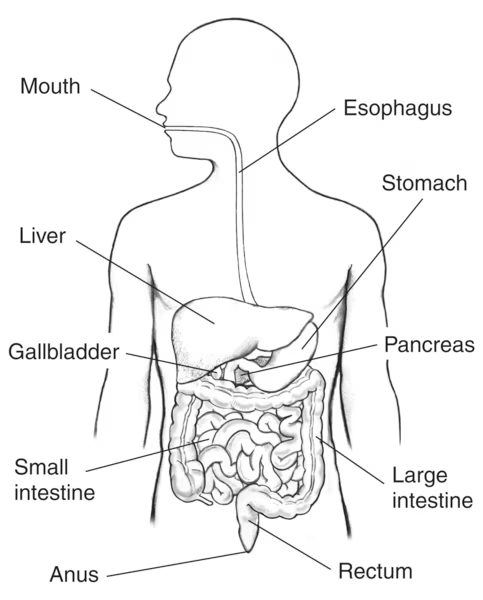
Digestion in Large Intestine
Receives undigested food + water from small intestine
Water reabsorbed into body
Forms faeces: water, bacteria, undigested food (can stay up to 3 days)
Faeces expelled via anus
Bacteria in Large Intestine
→ Helpful → make vitamins

Excretory (Urinary) System, Organs & Functions
Purpose: Remove toxic metabolic waste (e.g. urea, CO2, dead cells) from blood.
Made of "KUBU": 2 Kidneys, 2 Ureters, 1 Bladder, 1 Urethra.
Metabolism: All chemical reactions in cells/organs.
Lungs: remove gaseous waste (carbon dioxide) from the blood when exhale
Liver: Excretory organ that filters toxins and breaks down old red blood cells.
Kidneys: Filter blood, remove nitrogen waste, control water balance (osmoregulation); built from 1+ million nephrons—tiny filters that clean the blood.
Skin: Largest organ; excretes sweat from sweat gland (salt, urea) and sheds dead cells through sweat glands.
Ureters: Carry urine → bladder
Bladder: Stores urine
Urethra: Releases urine
Fun fact:
Faeces are brown from dead red blood cells (bilirubin).
CO₂ comes from cellular respiration.
Urea forms from protein breakdown.

Endocrine System
Made of glands that produce hormones (e.g., thyroxine, testosterone, insulin)
Receptor: special proteins on surface of cell which attach to hormone, and respond depending on hormone type, and change how cell behaves.
Hormones: Chemical messengers in blood → act on target cells, transported to where needed.
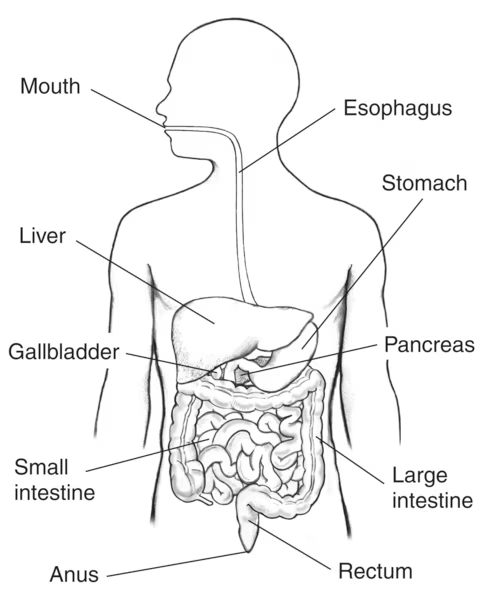
Endocrine vs Nervous System
Feature | Endocrine System | Nervous System |
|---|---|---|
Type of message | Chemical | Chemical (neurotransmitters) AND Electrical |
System that transports message | Circulatory system | Nervous system |
How message travels | Hormones in bloodstream | Electrical impulses through neurons |
Change detected by receptors | Yes | Yes |
Speed to reach target | Slow | Very fast |
Speed of response | Slow | Very fast |
Duration of response | Long-lasting | Short-lasting |
Distribution of response | Spread out to various cells/organs/tissues | Localised to one small area |
Homeostasis and its importance
Homeostasis
Maintaining a stable internal environment within narrow limits, despite external changes
Why it's important:
Allows growth, tissue repair, reproduction, and normal cell function
If internal conditions go beyond tolerance limits too long → malfunction, illness, or death
What it maintains:
BGL
Blood pH;
Blood CO2/O2 Levels;
Blood Pressure;
Heart Rate;
Blood Osmality;
Blood salt/electrolyte concentration.
Maintaining Homeostasis (Stimulus-Response Model)
Stimulus: Change in internal/external environment outside "set point"
Receptor: Specialized cells detect change and send message to control center
Control Center: Brain (hypothalamus/pituitary) sends message via nerves/hormones to effector
Effector: Muscle, gland, or organ responds to the message
Response: Counteracts the original stimulus, bringing system back to set point
Feedback Systems:
Most biological systems use negative feedback: change in opposite direction to restore balance (return to set point)
Thermoregulation
Thermoregulation
Endotherms (mammals/birds): Generate own body heat
Ectotherms (other animals): Rely on external sources (e.g., sun) for body heat
Thermoregulators receive info on skin.
Human Body Temperature Regulation
Set point: 37°C (range: 35.6°C - 37.8°C)
80% of energy from cellular respiration is used to maintain body temperature
Physiological Responses
Below 37°C: Vasoconstriction (blood vessel constriction, less close to skin, reduce heat loss), shivering (muscle movement), piloerection, increased metabolism
Above 37°C: Vasodilation (blood vessel expansion, closer to skin, heat loss), sweating
Negative Feedback Loop: Body Temperature Regulation
Stimulus: Temp goes above or below 37°C
Receptor: Thermoregulator on skin and hypothalamus detect change
Control Center: Hypothalamus processes the info, thyroid releases thyroxine for increased metabolism
Effector:
If too hot: Sweat gland and vasodilation
If too cold: Shivering and vasoconstriction
Response: Temp returns to normal (37°C)
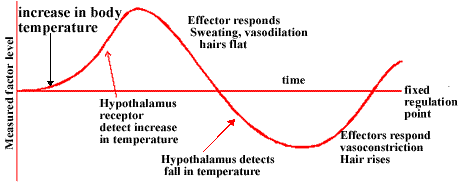
Behavioral Responses to Temperature Regulation
When Too Hot (Above 37.8°C):
Seek shade or cooler environment
Remove clothing to release heat
Increase water intake to cool down
Decrease physical activity to avoid generating more heat
When Too Cold (Below 35.6°C):
Seek warmth or heated environment
Add clothing or blanket to retain heat
Curl up to conserve warmth
Increase physical activity to generate more heat
Osmoregulation
Involves maintaining water balance and solute balance.
Water intake (gain):
Drinking/eating: ~2.4L
Metabolism (aerobic respiration)
Water loss:
Urine, faeces, evaporation, sweat: ~3.3L max
Importance:
Maintains blood solute concentration, volume, and pressure
Supports biochemical reactions (which occur in aqueous environments)
Physiological Osmoregulation
Physiological Osmoregulation
High Osmolality (low water in blood)
Detected by osmoreceptors in the hypothalamus.
Message Sent to Pituitary Gland
Pituitary releases ADH (Antidiuretic Hormone).
ADH Acts on Kidneys
Increases water reabsorption into the bloodstream.
Urine Becomes More Concentrated
Less water is lost in urine to conserve hydration.
If Well-Hydrated (Low Osmolality)
Low Osmolality
Hypothalamus detects sufficient water in blood.
Less ADH Released
Kidneys excrete more dilute urine, removing excess water
Negative Feedback System: Osmoregulation
Stimulus
High osmolality (low water in blood) or low osmolality (too much water in blood).
Receptor
Osmoreceptors in the hypothalamus detect changes in blood osmolality.
Control Center
Hypothalamus sends a message to the pituitary gland, which releases ADH (Antidiuretic Hormone).
Effector
Kidneys respond to ADH by adjusting water reabsorption.
Response
If dehydrated (high osmolality): Kidneys reabsorb more water, producing concentrated urine.
If overhydrated (low osmolality): Less ADH is released, leading to more dilute urine.
Glucose Regulation
Glucose is converted into ATP via cellular respiration by cells for energy.
Excess glucose is stored as glycogen in the liver and muscle cells. If there’s more, it’s converted to fat (or back to glucose if needed.).
BGL (Blood Glucose Level) is the concentration of glucose in the blood.
BGL is regulated within the range of 3.5 - 8 mol/L.
Blood Glucose Regulation - Physiological
Stimulus:
High or low blood glucose levels (BGL).
Receptor:
Chemorecetors on Pancreas detects BGL changes via alpha and beta cells.
Control Center:
High BGL: Beta cells release insulin.
Low BGL: Alpha cells release glucagon.
Effector:
Insulin: Lowers BGL by promoting glucose uptake and glycogen storage.
Glucagon: Raises BGL by stimulating glycogen breakdown and glucose release.
Response:
High BGL: Glucose uptake and storage.
Low BGL: Glycogen release into blood.
Negative Feedback Loop: Blood-Glucose Regulation

Blood-Glucose Response
Hyperglycaemia (High Blood Glucose): BGL above 8mmol/L, often seen in Type 1 diabetes.
Hypoglycaemia (Low Blood Glucose): BGL below the healthy range (typically below 4mmol/L).
Type 1 Diabetes
Autoimmune disorder where the immune system destroys beta cells in the pancreas, preventing insulin production.
Symptoms: High BGL, tissue/nerve damage, eye issues, kidney function decline, stroke.
Hyperthyroidism
Overactive thyroid gland, producing excessive thyroxine.
Symptoms: Increased metabolism, higher body temperature, weight loss, rapid heart rate, excess sweating.
Treatments: Medication or surgery to remove part of the thyroid.
Autotrophs and Heterotrophs
Autotrophs are organisms that can make their own food from light and inorganic molecules.
Heterotrophs is an organism that must consume other organisms to generate energy.
What is the difference between organic and inorganic compounds?
Organic Compounds:
Contain carbon atoms bonded mainly to hydrogen (C-H bonds).
Found in living things.
Examples: glucose (C₆H₁₂O₆), methane (CH₄), DNA.
Inorganic Compounds:
Usually do not have carbon-hydrogen bonds, such as minerals.
Found in non-living matter.
Examples: water (H₂O), sodium chloride (NaCl), carbon dioxide (CO₂ — exception: CO₂ is inorganic even though it has carbon).
Exam Tips
ALWAYS INCLUDE DATA WHEN COMPARING/EXPLAINING!